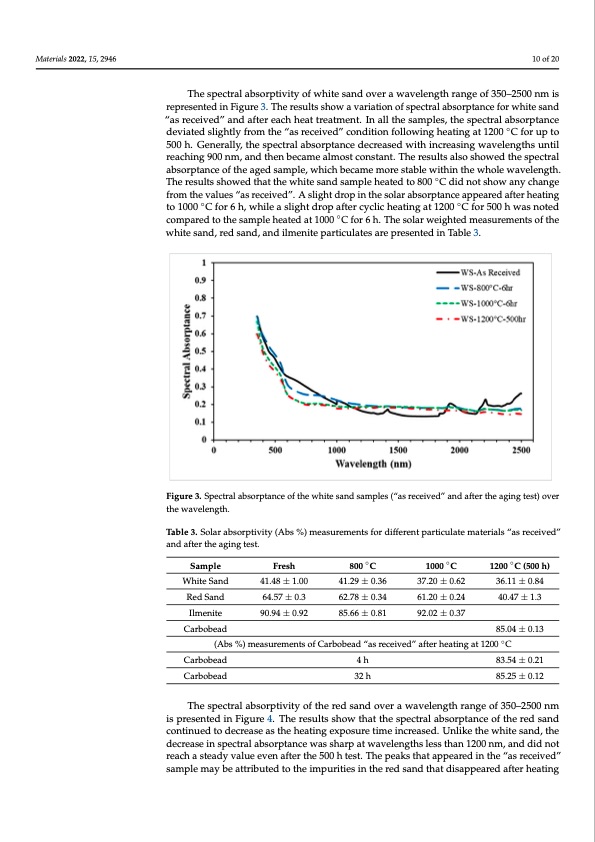
PDF Publication Title:
Text from PDF Page: 010
Materials 2022, 15, 2946 10 of 20 The spectral absorptivity of white sand over a wavelength range of 350–2500 nm is represented in Figure 3. The results show a variation of spectral absorptance for white sand “as received” and after each heat treatment. In all the samples, the spectral absorptance deviated slightly from the “as received” condition following heating at 1200 ◦C for up to 500 h. Generally, the spectral absorptance decreased with increasing wavelengths until reaching 900 nm, and then became almost constant. The results also showed the spectral absorptance of the aged sample, which became more stable within the whole wavelength. The results showed that the white sand sample heated to 800 ◦C did not show any change from the values “as received”. A slight drop in the solar absorptance appeared after heating Figure 3. Spectral absorptance of the white sand samples (“as received” and after the aging test) Figure 3. Spectral absorptance of the white sand samples (“as received” and after the aging test) over to 1000 ◦C for 6 h, while a slight drop after cyclic heating at 1200 ◦C for 500 h was noted Materials 2022, 15, x FOR PEER REVIEW ◦ 12 of 23 compared to the sample heated at 1000 C for 6 h. The solar weighted measurements of the white sand, red sand, and ilmenite particulates are presented in Table 3. over the wavelength. the wavelength. Table 3. Solar absorptivity (Abs %) measurements for different particulate materials “as received” Table 3. Solar absorptivity (Abs %) measurements for different particulate materials “as received” and after the aging test. and after the aging test. Sample Fresh 800 °C 1000 °C 1200 °C (500 h) Sample Fresh 800 ◦C 41.29 ± 0.36 1000 ◦C 37.20 ± 0.62 1200 ◦C (500 h) 36.11 ± 0.84 36.11 ± 0.84 40.47 ± 1.3 White Sand 41.48 ± 1.00 41.48 ± 1.00 64.57 ± 0.3 64.57 ± 0.3 90.94 ± 0.92 41.29 ± 0.36 62.78 ± 0.34 62.78 ± 0.34 85.66 ± 0.81 37.20 ± 0.62 61.20 ± 0.24 61.20 ± 0.24 92.02 ± 0.37 White Sand Red Sand 40.47 ± 1.3 85.04 ± 0.13 Red Sand Ilmenite 90.94 ± 0.92 Carb(oAbbesad%) measurements of Carbobead “as received” after heating at8152.040±°C0.13 ◦ 85.66 ± 0.81 Carbob(eAabds %) measurements of Carbobea4dh“as received” after heating at 120803.C54 ± 0.21 Ilmenite 92.02 ± 0.37 Carbobead Carbobead 32 h 85.25 ± 0.12 Carbobead Carbobead 4 h 32 h 83.54 ± 0.21 85.25 ± 0.12 The spectral absorptivity of the red sand over a wavelength range of 350–2500 nm is presented in Error! Reference source not found.. The results show that the spectral ab- The spectral absorptivity of the red sand over a wavelength range of 350–2500 nm sorptance of the red sand continued to decrease as the heating exposure time increased. is presented in Figure 4. The results show that the spectral absorptance of the red sand Unlike the white sand, the decrease in spectral absorptance was sharp at wavelengths less continued to decrease as the heating exposure time increased. Unlike the white sand, the than 1200 nm, and did not reach a steady value even after the 500 h test. The peaks that decrease in spectral absorptance was sharp at wavelengths less than 1200 nm, and did not appeared in the “as received” sample may be attributed to the impurities in the red sand reach a steady value even after the 500 h test. The peaks that appeared in the “as received” that disappeared after heating at high temperatures. Error! Reference source not found. sample may be attributed to the impurities in the red sand that disappeared after heating shows that the solar absorptance results for the red sand deteriorated significantly over time and temperature. The decrease in the absorptance was small at 800 and 1000 °C, but a strong deterioration in solar absorptance was observed along with the color change after the cyclic heating test at 1200 °C for 500 h. The red sand lost 37% of its solar weighted absorptance from its value “as received” after cyclic heating at 1200 °C for 500 h.PDF Image | Low-Cost Particulates Used as Energy Storage and Heat-Transfer Medium

PDF Search Title:
Low-Cost Particulates Used as Energy Storage and Heat-Transfer MediumOriginal File Name Searched:
materials-15-02946.pdfDIY PDF Search: Google It | Yahoo | Bing
Turbine and System Plans CAD CAM: Special for this month, any plans are $10,000 for complete Cad/Cam blueprints. License is for one build. Try before you buy a production license. More Info
Waste Heat Power Technology: Organic Rankine Cycle uses waste heat to make electricity, shaft horsepower and cooling. More Info
All Turbine and System Products: Infinity Turbine ORD systems, turbine generator sets, build plans and more to use your waste heat from 30C to 100C. More Info
CO2 Phase Change Demonstrator: CO2 goes supercritical at 30 C. This is a experimental platform which you can use to demonstrate phase change with low heat. Includes integration area for small CO2 turbine, static generator, and more. This can also be used for a GTL Gas to Liquids experimental platform. More Info
Introducing the Infinity Turbine Products Infinity Turbine develops and builds systems for making power from waste heat. It also is working on innovative strategies for storing, making, and deploying energy. More Info
Need Strategy? Use our Consulting and analyst services Infinity Turbine LLC is pleased to announce its consulting and analyst services. We have worked in the renewable energy industry as a researcher, developing sales and markets, along with may inventions and innovations. More Info
Made in USA with Global Energy Millennial Web Engine These pages were made with the Global Energy Web PDF Engine using Filemaker (Claris) software.
Sand Battery Sand and Paraffin for TES Thermo Energy Storage More Info
| CONTACT TEL: 608-238-6001 Email: greg@infinityturbine.com | RSS | AMP |